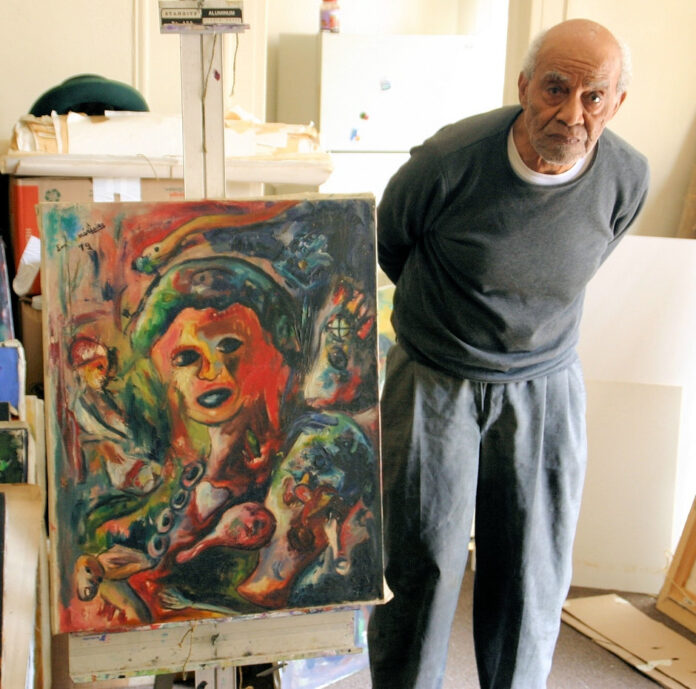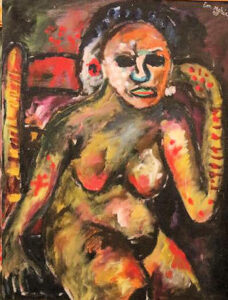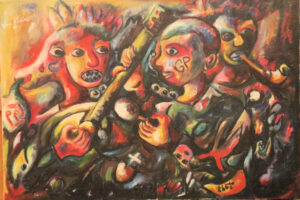
It’s an age-old war that Merisier had been fighting. The Centre-Foyer dynamic mirrors numerous similar antinomies that are as old as history – nature and culture, objectivity and subjectivity, freedom and slavery, etc.. As seen, reductively, if not altogether falsely, it’s understood as a dichotomy between so-called popular or working-class artists – with their would be (art-) historically directionless, instinct-driven works – and, in contrast, more formally educated, cosmopolitan artists – with their modern art-indebted output. Thus, especially in neocolonial settings, where the question of national identity has been of crucial importance to national liberation, it’s a dynamic that readily lends itself to divide and conquer tactics in the form of self-serving propagandistic art discourse by those with a vested political and economic interest in a targeted society to roil the possibility of its integration. ( Lerebours relates that after the Foyer Sophistiqués broke away from the Centre, Rodman red-baited them, and for a short time some of them, including Cédor, were harassed by the government.)
It’s true that the propaganda machine of the relatively better positioned Foreign Haitian Art Establishment had facilitated some degree of artistic and financial success for at least the original Primitif wave from the Centre. But this very wave, paradoxically, would also engulf the artists it pushed to the fore: the Primitif movement could hardly coast and advance on its own momentum. Without a local supportive cadre or locally vested supporters, it would seem that once a Primitif, always a Primitif – that is, a mere resource to be socio-economically tapped by mostly foreigners and their local allies.
Merisier’s streamlined production allowed him to unload the psychic and sexual tensions in his art
So the Primitif movement ebbs and flows, finding some renewed vigor sporadically in, say, later generations of accomplished figures such as Lafortune Félix and, more recently, Grand Rue artists such as André Eugène – but without its leading practitioners locally wielding independently, or through their own chosen collective, a degree of socio-political power and financial control over their output that’s commensurate with the high artistic status claimed for them. Merisier had sought to avoid this trap by maintaining some financial independence through his daytime construction job, by situating himself mostly in structures that are outside of the (Primitif) Haitian art market and, perhaps most of all, by branding himself as a Primitif Modèn.
Thus, Merisier’s maneuverings to boost his art career in New York and his pronouncements against the goals and accomplishments of the Foyer artists belie the fact that, in general, the Primitifs he favored had not really been given their art-historical due – even by their supposed champions. To this day, the art and life of Hector Hyppolite, the romanticized poster child of The Foreign Haitian Art Establishment and of a few native supporters and collectors, have hardly been seriously studied.
The two (in great part) amateurish and jejune catalogs on the artist’s three-year career that were printed some 60 years after his death in 1948 don’t prove the contrary. Furthermore, Hyppolite’s great Primitif peers – Bigaud, Benoit, Senêque and Philomé Obin, Liautaud, Duffaut – have received a fraction of the overall attention and exposure bestowed on him. Generally, they had much longer careers and produced, in various degrees, more qualitatively consistent work than he did. To that extent, Hyppolite’s supposed primacy among the Primitifs is still untested and arguably hollow.
More importantly, the original leading Primitifs and Sophistiqués whose careers took off in mid-century Haiti were the heirs and reinventors of a modern socio-political tradition, manifested implicitly in the earliest revolts against colonialism and, more explicitly, in their country’s independence – particularly, in Dessalines’ “Tout moun se moun” (“everyone is a person [or citizen]”) constitution of 1805. Surely, the rhetoric of revolt is a modernizing machine when actually sustained collectively and at the individual level by the Primitifs in their upholding, in form as well as content, of indigenous principles in their art. Rodman and his followers (as well as the Local Haitian Art Establishment) have not bothered to connect the art of the Primitifs with the modern aspects of Haiti’s political institutions. Why, for instance, not allow for correspondences between the Centre-Foyer dynamic and the social implication of the old, but still smoldering, nineteenth century socio-political contention between the country’s National and Liberal parties? Thus, the degree to which Rodman ignored the Primitifs’ negotiation of their connection to – or disconnection from – the national and state institutions of Haiti indexes the extent of his ignoring their artistic agency. As a Primitif Modèn, Merisier’s art conjoins the National Party’s slogan, “power to the more numerous” (his downtrodden gwo pèp) with that of the Liberal Party’s “power to the most capable” (his favorite European as well Primitif masters).
Moreover, Vodou itself is a multifaceted world-view rooted in African traditions. It’s also modern and even postmodern in that it both opposes and at the same time cannibalizes western traditions. The often ostensibly well-meaning Foreign Haitian Art Establishment, which is well aware of the overall stigmatization of Vodou (even in Haiti itself) has capitalized on this prejudice so as to turn a blind eye to its multidimensional or non-mystical aspects as a belief-system – particularly as manifested in Primitif art.
For instance, many years ago, in a Sunday slide presentation to a Haitian audience in Queens, the great erudite Robert Farris Thomson (who certainly was no follower of Rodman) once summarily dismissed the idea that a strong and captivating painting by Hector Hyppolite (showing flat stylized leaves around daubs of paint representing fluffy flowers in a vase resting on what looks like an oval place mat-like tabletop) could even be considered a still life proper. “Nature morte?” (“still life?”), he said flippantly, as if tweaking his presumed bourgeois, Francophile audience, and quickly pooh-poohed this possibility by demonstrating with enough persuasiveness the mystical aspects of the work (“Vase of Flowers”). Perhaps partly because I was not aware of his stature, I strongly took issue with his one-sided view. “Why can’t the painting be seen as both still life and as a symbolic representation of the spiritual and the mystical, even if not in equal degrees?” I asked. Upon noticing me before a subsequent talk at Brooklyn College, he humored me with an “Oh, no!” and graciously said to me on the side that he had misspoken the previous time.

Far from militating against his great accomplishments, Hyppolite’s non-Vodou-themed paintings and even his timid forays into sensationalism and commercialism humanize him as a multidimensional man. Similarly, Merisier’s uniformly sized breakthrough paintings were arguably motivated by market concerns, although, when he was not up to it, he’d spend months without actually producing any art. (Often, modern and contemporary artists do have to produce enough to feed and satiate the ravenous art market beast. Compared to the Sophistiqués, the relative success of the Primitif artists had much to do with the fact that there was a market created for their art.)
Yet, unlike Hyppolite, Merisier’s streamlined, would-be rash production also proved liberating, allowing him to unload the psychic and sexual tensions in his art. (Many of his breakthrough paintings are about male-female, male-male couples calmly experiencing as if a hard-won modus vivendi.) Having a Vodou world-view does not necessarily lock one up in a spiritual-mystical universe, just as Merisier’s “Matisse and Hyppolite” has little to do with Hyppolite and Matisse. Merisier more than once acknowledged that he did in fact borrow visual ideas from other artists before starting a painting. But, confident in the way he could transform and process what he borrowed, Merisier would dare his interlocutors with: “Men, montre m kote m pran l!” (“But show me where I borrowed it from!”). Indeed, as is the case with a lot of (early) Primitif works, most of the titles of Hyppolite’s paintings are not his, but presumably that of buyers or collectors. Somewhat similarly, Merisier’s titles, as seen in “In memory of Wifredo Lam” are mere entry points to his art’s actual content. He was at times cavalier in the way he assigned them to similarly themed works. In fact, many of his paintings are untitled. Thus the central problem that has stymied the entire field of – yes, Primitif Modèn art, we could say – right up to the Grand Rue sculptors, has been basically the lack of due visual scrutiny and interpretive passion invested in particular works as they relate to the overall output of individual artists who may be of the same background and class but of vastly different experiences, capacities, and ambition. The get-it-quick-praise-it-high-flip-it-soon mentality that pervades the field (which over the years, aside from being allegedly vitiated by forgeries, has drawn very little sustained scholarship or even plain, disinterested intellectual passion) has pretty much factored out the complexities of the lives and thinking of some great individual artists.
His art is about art truths, which spring from the vaunted autonomy inherent to modernist art.
For example, although Hyppolite was an oungan and artist, he was also an individual, a man and citizen whose life and art strongly suggest that he had preoccupations that had at least as much to do with Vodou as with (among other universal themes) sexuality, the tragedy of power and blackness, or the mundane need to make a buck. For those who are familiar with his work or life, his preoccupation with sexuality is evident in paintings such as “General Baubou and the Mambo,” or in “Un jeu d’enfant dans la rue,” or in the words he reportedly let out to Remponeau who was visiting his women-filled waterfront lakou (compound), “Tout fanm sa yo se pa m!” (“All these women are mine!”). On the tragedy of blackness and power note, for example, among other works, one might cite his “Ogou on his Charger,” “L’union fait la force,” or “Monument to Dumarsais Estimé.” As for his pecuniary concerns, Hyppolite could also satisfy tourist thirst for sensationalism – what with his complacently laid out and perfunctorily painted “Magie noire.” Or, unlike Merisier, he could oblige buyers with middlebrow taste by painting for them commercially tinged, run-of-the- mill fare such as “Citadel,” “Windmill” and “Fruit Trees.”
Merisier’s maneuverings around and engagement with The Foreign Haitian Art Establishment was not quite fruitful in that what he wanted most of all was the categorical critical support of Rodman. In the early nineties, he actually pressed Rodman to see his paintings. Once, when Antonio Joseph was being shown at Rodman’s private home in Oakland, NJ, I reluctantly drove Merisier there with a few of his works, as he had requested my help. Then at the opportune time, I helped him unload a few paintings in Rodman’s backyard and then prop them against my car’s bumper. Rodman came out like a seigneur and, tight-lipped, took seconds to inspect the paintings before returning abruptly to his guests. I seethed at the degradation of Merisier showing his art as if to a blan deigning to glance at the wares of obliging sidewalk artists back in Port-au-Prince. But, to Merisier, it was mostly business.
(At Joseph’s opening inside the house, I had held out my hand to Rodman to tell him that he had done a lot for Haitian art and then pumped his hand to assure him, poker-faced or haughty as he was, that I meant what I said. Indeed, just as the Grand Rue artists – Atis Rezistans – have received little support from Haiti’s upper classes, the leading Primitifs generally have not fared much better, in spite of the lip service the Haitian government indirectly paid to them in decreeing 2008-2009 “The Year of Hector Hyppolite.”)
As seen in the relatively unserious way Merisier and his art have been dealt with in general, the trap had already been laid out for him. It may very well factor out the complexities of his life and thinking if the dynamic truths of his life and art are not ferreted out, asserted, and fearlessly inscribed on the walls of the Haitian imaginary.
Epilogue: Or Playing With Traps
Merisier finally got his show at Rodman’s home. Many days later, Merisier received from Rodman the written text that he had requested and that he thought would be the ultimate critical backing for his art. In three brief, manually typed, unsigned paragraphs with handmade corrections, the octogenarian Rodman states that he’s “the world’s leading authority on Haitian art” and that one of Merisier’s paintings would be added to his collection at Ramapo College, the “outstanding public repository of Haitian art in the United States.” Then Rodman quotes what he supposedly had said to his guests at Merisier’s opening: “This is the first show of Haitian art that must be considered not merely in the category of ‘popular’ or ‘primitive’ art but in the mainstream of modern art in the twentieth century.” Virtually all of this statement is patently false, complete hogwash. Still, Merisier seemed to have resigned himself to Rodman’s words, even though at the very bottom edge of the page on which they appear one could detect a signed, hand-written, and skewed sentence addressed to what looks like, oddly, the name of his brother Mortes that says: “I hope that’s what you wanted.” It’s not clear whether Merisier managed to share this nauseating blurb with the Local Haitian Art Establishment during his two trips to Port-au-Prince. But he was innocent – and contrary – enough to attempt it. (I had made public the first essay I wrote on him, “The powerful Art of Emmanuel Merisier,” in 1986.)

Part of the tragedy in (modern) Haitian art history is that the lives as well as the thinking and feelings of artists are seldom valued or parsed to the extent that they should be. Generally, their works are not made to reflect their lives – in full. The same applies to Merisier in the way that, especially, the Foreign Haitian Art Establishment has treated him. The Waterloo Museum, to which he ostensibly donated in 2013 about 40 of his greatest works – none of which are slated for Haiti – hastily and complacently recompensed him about four months later with a solo show of as many paintings. Museum personnel supplemented the exhibition with a two-leaf brochure containing the artist’s requisite resumé and bibliography and then just two brief perfunctory paragraphs – one on his biography and the other mostly on his combining “modernism and Haitian primitive style.”
Fortunately, Merisier’s art is so enmeshed with his life that both will endure. His art is ultimately not so much about the truths in our world… or even in his life. It’s first and foremost about art truths, which spring from the vaunted autonomy inherent to modernist art. It’s this autonomy that ensures the permanence and power he sought, not just for himself as immortal artist, but for his subjects and themes, the gwo pèp of Haiti. (Just recently, Merisier’s niece, Lunie, recounted how he once made light of the fact that a relative was a doctor. No one, he suggested to her, will remember the doctor once he’s dead.)
Dressed up, so to say, as many of his paintings seem to be, for an art-historical stage, their reflection of the tragic, seemingly permanent condition of the gwo pèp’s lives interfaces with and secures for posterity the dynamic truth of his own life as artist. Through this interfacing, this mirror identity, Merisier rescues and consecrates the gwo pèp and assures, metaphorically, its power to endure and, ultimately – when the truth of his life and art is fully gauged – to triumph.









